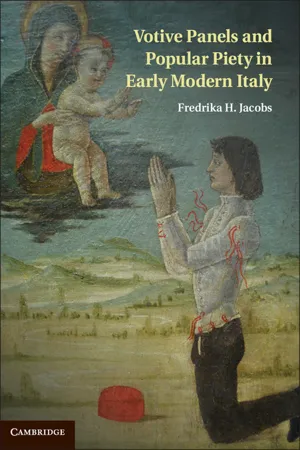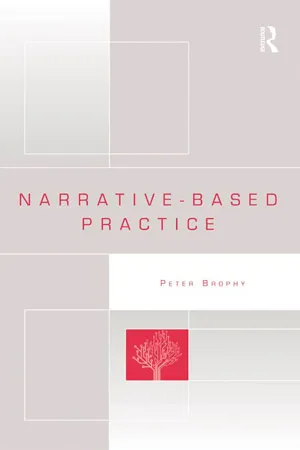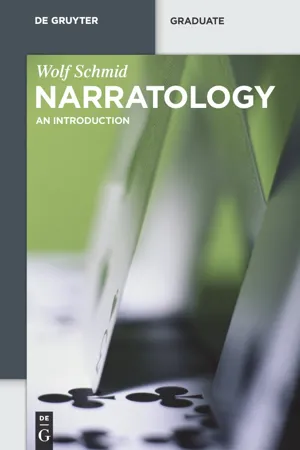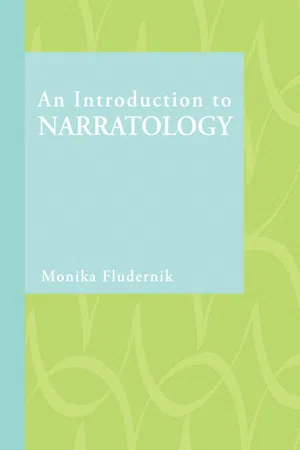Literature
Narrative Mode
Narrative mode refers to the method or style through which a story is presented to the reader. It encompasses various techniques such as first-person narration, third-person omniscient, and second-person narration. The narrative mode chosen by an author can significantly impact the reader's experience and understanding of the story.
Written by Perlego with AI-assistance
Related key terms
1 of 5
7 Key excerpts on "Narrative Mode"
- eBook - PDF
Contemporary Narrative
Textual production, multimodality and multiliteracies
- Fiona J. Doloughan(Author)
- 2011(Publication Date)
- Continuum(Publisher)
Language can be delivered in the spoken mode or the written mode and transmitted via audio or video, for example; language in the written mode can be presented in print or on screen, two different media which, as we will see, have the capacity to impact upon the organization and conguration of the written text, particularly in New Perspectives on Narrative 7 cases where many modes are employed to deliver the message, communicate ideas or construct a narrative. Before turning to an overview of the literature on narrative and sketching out the main areas of contention in narrative theory and accounts of narrative practice, let me set out the principal concerns and key ideas of the book. It attributes recent developments in narrative to a number of factors, including technological advances and the affordances of the new media; and to increasing multilingualism and multiculturalism. It inscribes a multidimensional view of text and sees all texts, including narrative texts, as potentially multimodal. It sees writers as skilful and responsive readers of text who create new texts from imaginative reworkings and creative transformations of previous texts. As material artefacts produced by human subjects, it suggests that the pro-duction of new narratives depends on access to a range of linguistic, cultural, social and technological resources. Conceptualizations of and Approaches to Narrative As David Herman (2007) makes clear in his introduction to The Cambridge Companion to Narrative , approaches to narrative can essentially be divided into the classical and the post-classical (p. 12). - Fredrika H. Jacobs(Author)
- 2013(Publication Date)
- Cambridge University Press(Publisher)
126 IV Narrative ModeS Narrative is first and foremost a prodigious variety of genres, themselves distributed amongst different substances.... Narrative ... is simply there, like life itself. Roland Barthes, Image, Music,Text, 1977 1 Telling stories about particular experiences is the primary human mechanism for bestowing meaning upon them. They reveal not so much actual happenings as the underlying meanings attributed to events. David Gentilcore, Healers and Healing in Early Modern Italy, 1998 2 Communication does not stand apart from reality. There is not, first, reality and then, second, communication about it. Communication participates in the formation ... of reality. Richard V. Ericson, “How Journalists Visualize Fact,” 1998 3 With a remarkable economy of words and consistency in language, miracle- book entries note that ex-votos aver four things. 4 First, the votary suffered a debilitating illness or confronted a life-threatening situation (in pericolo di morte). Second, having abandoned all hope for help from a physician or other human being (disperato dell’aiuto de’medici; abbandonato dale cure dei medici), the endangered or afflicted person turned heavenward, promising in the moment of duress to honor a holy benefactor in return for divine intercession. Third, working with and through his saintly representatives, God resolved the cri- sis, restoring health to the diseased, rescuing the imperiled, and liberating the enslaved and possessed (fù subito sanato et liberato). Finally, having made a vow (fece voto, facto el boto) and in receipt of grace (per grazia ricevuta), the miracolato journeyed to the shrine of the intercessor who had attended to him or her in a time of need. Once there, the supplicant performed acts of veneration.- eBook - ePub
- Peter Brophy(Author)
- 2016(Publication Date)
- Routledge(Publisher)
The plot is never explicit; rather it is inferred by the listener from the discourse. At the same time, different discourses may have the same plot, which is why it is possible to translate narratives successfully in a way that is difficult with, for example, non-narrative poetry. But because certain plots are frequently encountered, they achieve familiarity and enable the listener to explore meaning in the particular context of the story and the storyteller. In organisational settings, this can be an important way to achieve relevance.Style
Narrative style refers to the way in which the narrative is presented. It includes point of view (considered further below), but also refers to the manner in which the story is told. For example, a newspaper report could be written in short, staccato phrases using contemporary jargon and references, or in longer, complex sentences perhaps with subclauses and explanations in parentheses using formal terminology. The latter would be perceived as a more ‘academic’ style and perhaps treated with more gravitas. The former would be more immediate, grabbing the attention. However, the two would not necessarily convey the same meaning, even to the same listener because style affects what is perceived.The way in which concepts are connected is also critical in conveying meaning, as Winterowd illustrates in the following observation:Take the two propositions The Lone Ranger rode a horse and The horse saved his life and combine them thus: The Long Ranger rode a horse that saved his life. The result is that one preserves the meaning of each proposition and creates their new, relational meaning.. Nor is the creation of meaning through embedding a trivial quality, but rather one of the great creative powers that the language confers upon its users: the power to express relationships through a finite series of recursive devices. (Winterowd 1975: 29)Point of View
The point of view of a narrative refers to the standpoint or standpoints of the narrators, not to an opinion which they take – it sometimes referred to as the narratives ‘focus’ or ‘angle’:Like the camera in a film, the perspective of a narrative is always located somewhere, up above events, in amongst them, or behind the eyes of one or more of the characters involved. Like the film camera, the narrative voice can move around from one point of view to another, often shifting undetectably from outside to inside views. (Currie 1998: 18) - eBook - ePub
A Narratology of Drama
Dramatic Storytelling in Theory, History, and Culture from the Renaissance to the Twenty-First Century
- Christine Schwanecke(Author)
- 2022(Publication Date)
- De Gruyter(Publisher)
The existence of genre-specific modes and features, which are always transgenerically applicable, has the following implications for the present study on the intersections of drama and narrative within drama: Any play can potentially display, besides its default mode (i.e., the dramatic mode), modes that either originated in other genres and/or are conventionally tied to them. Besides conventionally dramatic features, it can entail narrative ones. Conventions developed in the Gothic novel (a narrative genre), for instance, which are even today predominantly linked to narrative as a mental schema, can be used to play with (schemata of) genres within a dramatic work. Gothic modes and features can be increasingly employed in a play to change mental frames of reception: what originally started as a realist play is turned into a Gothic tale (cf., e.g., Sect. 6.2).A play that, by way of its discourse, employs and highlights a lot of Narrative Modes, is likely to be, in analogy to the cognitive processing formula “seeing X as Y” (Jahn 2008 , 67), regarded as dominantly narrative. Differently put, Narrative Modes in plays (given a certain quality, quantity, and salience, and given certain ways in which they are combined with other modes) potentially trigger the actualisation of the mental schema of ‘narrative’ in the mind of receiving readers or audiences, even if plays are conventionally categorised (and understood) as belonging to the generic category of drama. What is traditionally regarded as Narrative Mode (such as a narrator’s framing of a diegetic level) can be employed in a play (a narrative instance’s framing of a play’s diegetic level in the form of generative narrators like Gower in Shakespeare and Wilkins’ Pericles; cf. Sect. 4.3). Furthermore, this mode can be even combined with modes conventionally regarded as dramatic (e.g., dialogue) in a play and thus, develop new and fascinating genre-indeterminate modes of expression (as in the dialogic generative frame of John Gay’s The Beggar’s Opera; cf., e.g., Sect. 5.3).What is more, Narrative Modes and features can be even employed in such a way – both in dramatic narration and on a play’s story level – that they come to outweigh dramatic ones: the latter diminish while the former, at the same time, accrue. When there is, for example, a reduction of dialogue in favour of monologue and the cut of action in favour of diegetic (sensu verbal) acts, as in Richard Cumberland’s The West Indian - eBook - PDF
- S. Keen(Author)
- 2003(Publication Date)
- Palgrave Macmillan(Publisher)
That said, Narrative Form is located squarely in the field of literary studies, where the study of narrative has been going on for nearly a century. Familiarity with the terms and techniques commonly used in literary studies should permit the venturesome to enter interdisciplinary conversations confident of their ability to identify and describe the aspects of narrative that inter- est them. Even if an advanced student has no deep interest in narrative form, understanding the claims of narrative theory can still be useful. Narrative theory provides an extremely detailed vocabulary for the description of the component parts and various functions of narrative, but only a few advanced students will go on into the sub-field of narratology. Many will be drawn to narrative literature, but will find contextual, thematic, or other theoretical approaches more immediately compelling. The approach to nar- rative form that I take in this handbook emphasizes the craft of fiction, and honors the makers and feigners who shape words to build story worlds in the minds of readers. It is my hope that advanced students who are drawn to narrative simply because they love to read will find the description of the narrative artist’s tool-kit of interest. In the process of reading this book, advanced students will acquire tools of their own for making critical dis- tinctions and clarifying their observations about a writer’s craft. It is true that many critics are skeptical of the underlying assumption of formalist analysis, and that others shrink from anything that sounds like theory at all. I believe that the evidence of contemporary writing suggests that formal choices still matter to the makers of fiction. - eBook - PDF
- Wolf Schmid, Alexander Starritt(Authors)
- 2010(Publication Date)
- De Gruyter(Publisher)
The least complicated terminological way to represent our findings is to refer to narrative in the broader sense simply as “narrative,” while narrative in the narrower sense can be sensibly referred to with the term “mediated.” The theory presented in this book refers to those texts in which the classical concept of narrativity coincides with the structuralist one. Its sub-ject matter will therefore be literary texts that present a story and thereby represent, more or less explicitly, the mediating authority of a narrator. (This certainly does not mean that most of the categories handled cannot be applied to narrative texts in the broader sense.) The typology of texts is illustrated in the following diagram (the mass of mediated narrative texts on which the present book concentrates has been emphasized with a double border; the remaining text types, discursive, edifying, didactic etc. texts, are not further differentiated): Texts Narrative texts (in the broader sense) = represent a story Descriptive texts = represent states Remaining texts Mediated narrative texts (= narrative texts in the narrower sense) The story is told by a narrator. Mimetic narrative texts The story is portrayed with-out a mediating narrative auth-ority. This diagram is a modification of Seymour Chatman’s well-known model (Chatman 1990, 115), in which narrative texts are subdivided into “diegetic texts, recounting an event with the mediation of a narrator,” and “mimetic texts, enacting the event without a mediation.” 11 11 The words diegetic and mimetic are meant here in the sense used by Plato, whose Republic (III, 392d) distinguishes between diegesis (= pure narration) and mimesis (= imitation of the 8 I. Features of narrative in fiction d) Events and eventfulness Literary theory must do more than just register the presence of changes of state. Even the shortest of stories, not to speak of novels on the scale of Tol-stoy’s War and Peace , will represent a vast number of changes. - eBook - ePub
- Monika Fludernik(Author)
- 2009(Publication Date)
- Routledge(Publisher)
In literature, however, the level at which the story is mediated to the reader is usually perceived as being of secondary importance in relation to the plot. The narrator is frequently nothing more than a disembodied voice. 2 we -narratives The distinction we have just made between first- and third-person narration (or homodiegesis/heterodiegesis) includes further possible variants. In fact, the range of possible relationships that narrators, narratees and characters can enter into is potentially rather wide. We -narrative is fairly common in spoken interaction: couples, soldiers, sportspeople, students, scouts – they all experience exciting events together and then give their accounts of these in the first person plural. But we can also tell and write about other people in the plural (they -narrative), although the use of such narratives is much rarer. In narratological studies we -narrative has mainly been analysed by Uri Margolin and Brian Richardson (for instance, Margolin 2000, Richardson 2006). you -texts Second-person narratives, which tell the story of a narratee, are a particularly interesting case. In fiction in English and in the Romance languages one finds a fair number of works tailored along these lines. Italo Calvino’s If on a Winter’s Night a Traveller (1979) begins by addressing the reader and then continues with a description of how this reader went to a bookstore and purchased the book being read. You are about to begin reading Italo Calvino’s new novel, If on a winter’s night a traveler [ sic ]. Relax. Concentrate. Dispel every other thought. Let the world around you fade. Best to close the door; the TV is always on in the next room
Index pages curate the most relevant extracts from our library of academic textbooks. They’ve been created using an in-house natural language model (NLM), each adding context and meaning to key research topics.






